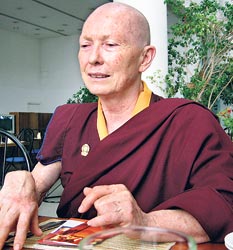by Pema Khandro, the Buddhist Channel, Jul 6, 2015
Yogyakarta, Indonesia -- The Sakyadhita International Conference on Buddhist Women met for one week in beautiful, humid, Yogyakarta, Indonesia. Over a thousand people, from different countries and different Buddhist traditions, gathered to discuss the history, concerns and achievements of women in Buddhism.
 Karma Lekshe Tsomo, founder of Sakyadhita International Association of Buddhist Women Karma Lekshe Tsomo, founder of Sakyadhita International Association of Buddhist Women
Approximately half of the attendees were from Indonesia and the other half were from around the world. Each day there were academic presentations, workshops, shared meals, dharma talks and other activities happening.
Sakyadhita International Association of Buddhist Women was founded in 1987. Sakyadhita, means “Daughters of the Buddha.” “The organization aims to unite Buddhist women of various countries and traditions, to promote their welfare, and to facilitate their work for the benefit of humanity. Sakyadhita now has nearly 2,000 members in 45 countries around the world.” The founder of the organization is Karma Lekshe Tsomo, a kind and immensely skillful leader.
Non-sectarianism was an implicit theme of the conference, in addition to the explicit theme of “Compassion and Social Justice.” Since all the attendees were admiring one another, the atmosphere of non-sectarianism was in the air as a palpable constant ambience of mutual appreciation.
Women from different countries walked around wearing each of their different colors of robes, representing the practices of Theravada, Mahayana, Vajrayana and Zen. These ordained nuns came from Korea, Tibet, Indonesia, Malaysia, Japan, North America, Vietnam and more.
There was so much diversity in the robes and customs from different Buddhist traditions. One aspect that is unique to bhikunis is the keeping of hair. For instance, the Ngakpas, and Naljorpas are from an ordained lineage that keeps long hair. It is part of the Buddhist Yogi’s tradition of Tibetan Buddhism to keep the hair.
Sometimes one can see yogis who have extremely long hair. This is an expression of belief that the whole phenomenal world is pure and sacred, that it has Buddha nature and our body also has Buddha nature.
But it is not just the Ngakpas and Naljorpas that keep long hairs, Japanese Zen nuns also keep their hair and that they also marry. This is one of the most joyous and important things about the Buddhist Yogi’s tradition. In both these lineages, the ordained sangha may marry.
On the final days of the conference there were tours to local Buddhist temples (which had been around since the 8th century). Participants also meditated at sunrise with Jetsunma Tenzin Palmo, initially with a small group from the conference which later grew into a significant crowd which included tourists who were in the area. |
 Karma Lekshe Tsomo, founder of Sakyadhita International Association of Buddhist Women
Karma Lekshe Tsomo, founder of Sakyadhita International Association of Buddhist Women
No comments:
Post a Comment